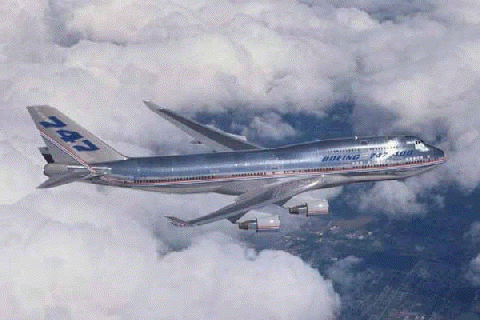

If so instructed by your teacher, print out a worksheet page for these problems.
Open the slide called Determining Center of Gravity (with text) and read the explanation on how an airplane in flight will rotate about a point in the airplane called the center of gravity.
A Boeing 747-400 domestic airplane is soaring the friendly skies (shown below). Use data from the Boeing Website to complete Table 1. Estimate values for data you are unable to locate in a reasonable amount of time. Click Boeing Website to access a partial list of 747 data. You should be able to find the length of the airplane (for the reference distances requested), the mass of the engine, and the fuel capacity. The distances in Table 1 should be measured from a reference line that starts at the nose (front) of the 747. Use the BACK key to return to this page.
Problem 1 will guide you in the calculation to find the mass of the fuel.
All problems are expressed in metric units.

|
|
|
||
|
|
|
||
|
|
|
||
|
|
|
||
|
|
|
||
|
|
|
||
|
|
|
||
|
|
|
- What is the fuel
capacity of the 747?
Fuel capacity = Volume of fuel = ______________
- Assuming the density
of an average jet fuel is 0.75 g/ml, use the density equation,
density = mass / volume, to calculate the mass of the fuel. (Hint: You must convert from liters to milliliters.)
Mass of fuel = ______________
Record this value for the mass of the fuel in Table 1.
- In Table 2, record
the weights of the components (parts) listed in Table 1.
(Hint: Remember, F = mag = W. The acceleration due to gravity, ag , is 9.8 m/s2.)
Table 2 : Airplane component weightsMass (kg) Weight (N) payload w1 engine w2 wings w3 fuselage w4 fuel w5 vertical tail w6 horizontal tail w7 - What does n equal?
[Hint: The number n is the number of quantities being added together.]
n = _________
- What are the values
for i?
i = _________________________
- What is the total
weight W of the airplane?

- What is the value
of the sum of the component weights times their distances from the reference
line (see the equation below)?

- Using your answers
from Problems 6 and 7, calculate the center of gravity.

- After a long flight,
the amount of fuel left in the tanks is 20% of the initial amount. What
is the mass and weight of the fuel that is left? Record your answers
in Table 3.
Table 3 : Remaining Fuel DataMass (kg) Weight (N) Remaining Fuel - Recalculate the
airplane's center of gravity with the reduced fuel weight.

- Did the center
of gravity change?
- If yes, by how many meters did the center of gravity move?
- If yes, did the center of gravity move toward or away from the nose of the airplane?
- Do you think the pilot would notice such a change in the center of gravity while flying? Why?
EDUCATOR RESOURCES | AERONAUTIC EDUCATIONAL RESOURCES | INTERNET ACCESS RESEARCH | ICING RESEARCH TUNNEL
BEGINNER'S GUIDE TO AERONAUTICS | FREE SOFTWARE | AERODYNAMICS INFORMATION | AERODYNAMICS PROBLEMS | PROPULSION INFORMATION |
PROPULSION PROBLEMS | FOILSIM INFORMATION | FOILSIM PROBLEMS | ENGINESIM INFORMATION | ENGINESIM PROBLEMS | ROCKETMODELER
AERONAUTICS LESSONS & ACTIVITIES | WIND TUNNEL WEB PAGES | AERONAUTS 2000 | VIDEOCONFERENCES WITH THE U.K.
Curator: Tom.Benson@grc.nasa.gov
Responsible Official: Kathy.Zona@grc.nasa.gov